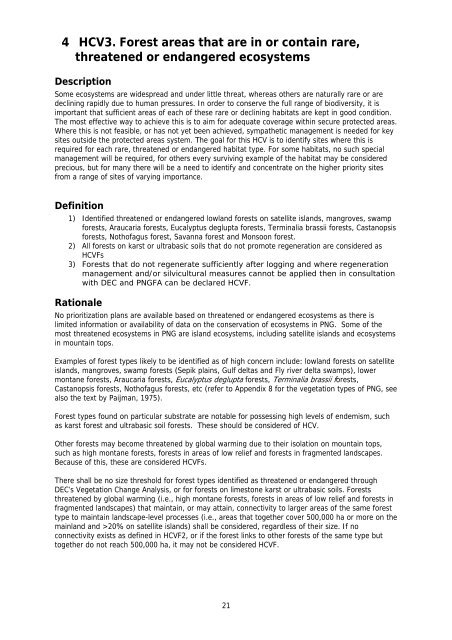A National Interpretation of the High Conservation Value Forest ...
A National Interpretation of the High Conservation Value Forest ...
A National Interpretation of the High Conservation Value Forest ...
You also want an ePaper? Increase the reach of your titles
YUMPU automatically turns print PDFs into web optimized ePapers that Google loves.
4 HCV3. <strong>Forest</strong> areas that are in or contain rare,<br />
threatened or endangered ecosystems<br />
Description<br />
Some ecosystems are widespread and under little threat, whereas o<strong>the</strong>rs are naturally rare or are<br />
declining rapidly due to human pressures. In order to conserve <strong>the</strong> full range <strong>of</strong> biodiversity, it is<br />
important that sufficient areas <strong>of</strong> each <strong>of</strong> <strong>the</strong>se rare or declining habitats are kept in good condition.<br />
The most effective way to achieve this is to aim for adequate coverage within secure protected areas.<br />
Where this is not feasible, or has not yet been achieved, sympa<strong>the</strong>tic management is needed for key<br />
sites outside <strong>the</strong> protected areas system. The goal for this HCV is to identify sites where this is<br />
required for each rare, threatened or endangered habitat type. For some habitats, no such special<br />
management will be required, for o<strong>the</strong>rs every surviving example <strong>of</strong> <strong>the</strong> habitat may be considered<br />
precious, but for many <strong>the</strong>re will be a need to identify and concentrate on <strong>the</strong> higher priority sites<br />
from a range <strong>of</strong> sites <strong>of</strong> varying importance.<br />
Definition<br />
1) Identified threatened or endangered lowland forests on satellite islands, mangroves, swamp<br />
forests, Araucaria forests, Eucalyptus deglupta forests, Terminalia brassii forests, Castanopsis<br />
forests, Noth<strong>of</strong>agus forest, Savanna forest and Monsoon forest.<br />
2) All forests on karst or ultrabasic soils that do not promote regeneration are considered as<br />
HCVFs<br />
3) <strong>Forest</strong>s that do not regenerate sufficiently after logging and where regeneration<br />
management and/or silvicultural measures cannot be applied <strong>the</strong>n in consultation<br />
with DEC and PNGFA can be declared HCVF.<br />
Rationale<br />
No prioritization plans are available based on threatened or endangered ecosystems as <strong>the</strong>re is<br />
limited information or availability <strong>of</strong> data on <strong>the</strong> conservation <strong>of</strong> ecosystems in PNG. Some <strong>of</strong> <strong>the</strong><br />
most threatened ecosystems in PNG are island ecosystems, including satellite islands and ecosystems<br />
in mountain tops.<br />
Examples <strong>of</strong> forest types likely to be identified as <strong>of</strong> high concern include: lowland forests on satellite<br />
islands, mangroves, swamp forests (Sepik plains, Gulf deltas and Fly river delta swamps), lower<br />
montane forests, Araucaria forests, Eucalyptus deglupta forests, Terminalia brassii forests,<br />
Castanopsis forests, Noth<strong>of</strong>agus forests, etc (refer to Appendix 8 for <strong>the</strong> vegetation types <strong>of</strong> PNG, see<br />
also <strong>the</strong> text by Paijman, 1975).<br />
<strong>Forest</strong> types found on particular substrate are notable for possessing high levels <strong>of</strong> endemism, such<br />
as karst forest and ultrabasic soil forests. These should be considered <strong>of</strong> HCV.<br />
O<strong>the</strong>r forests may become threatened by global warming due to <strong>the</strong>ir isolation on mountain tops,<br />
such as high montane forests, forests in areas <strong>of</strong> low relief and forests in fragmented landscapes.<br />
Because <strong>of</strong> this, <strong>the</strong>se are considered HCVFs.<br />
There shall be no size threshold for forest types identified as threatened or endangered through<br />
DEC’s Vegetation Change Analysis, or for forests on limestone karst or ultrabasic soils. <strong>Forest</strong>s<br />
threatened by global warming (i.e., high montane forests, forests in areas <strong>of</strong> low relief and forests in<br />
fragmented landscapes) that maintain, or may attain, connectivity to larger areas <strong>of</strong> <strong>the</strong> same forest<br />
type to maintain landscape-level processes (i.e., areas that toge<strong>the</strong>r cover 500,000 ha or more on <strong>the</strong><br />
mainland and >20% on satellite islands) shall be considered, regardless <strong>of</strong> <strong>the</strong>ir size. If no<br />
connectivity exists as defined in HCVF2, or if <strong>the</strong> forest links to o<strong>the</strong>r forests <strong>of</strong> <strong>the</strong> same type but<br />
toge<strong>the</strong>r do not reach 500,000 ha, it may not be considered HCVF.<br />
21

















